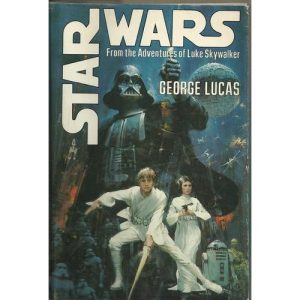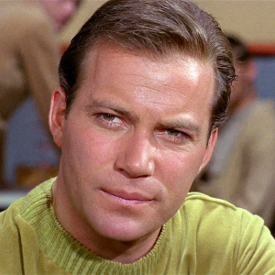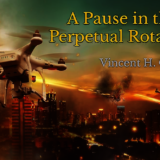Which came first, the book or the movie? Often the movie industry draws on the fandom of its audience to garnishee more revenue. The novelization of a new film is an ideal way to gain exposure as well as fill the void between the production of new installments. Few will deny the marketing genius of George Lucas and the Star Wars franchise, which will probably involve re-re-re-released versions in holographic form by the time this is read. But as we look back almost forty years, and in the shadow of renewed installments of films, the line between movie and book has become blurred.

George Lucas wrote and directed the initial Star Wars movie which was released on May 25 1977 (we won’t get into the evolution convolution of episodes here). Lucas is also billed as the author of the earlier 1976 edition of Star Wars: From the Adventures of Luke Skywalker, but the novel was ghostwritten by Alan Dean Foster. It’s understood that a successful writing process involves establishing a sound back-story, but the elasticity used in creating the world of Star Wars has made for some intriguing discrepancies when comparing the literary version with the one on the screen. I’ve no doubt some if not all of these have been pointed out over the years by loyal fans, but this being my first encounter with this particular edition, I felt obligated to share my thoughts.
First and foremost a prologue similar to the familiar back-story roll-up begins the tale. In the book, this comes from an account from what is called the First Saga provided by a source known as the Journal of the Whills. Notable is the Emperor’s lack of being in power and that he in fact is being controlled by the same officials he had appointed below him. Instead of one all powerful bad guy, the evil empire is comprised of a more sinister bureaucracy. The plausibility of this, in today’s political climate, gives the story a lot more credibility than any mystical elements the Sith may bestow.
Early in the tale, the reader is introduced to Luke’s friend Biggs. An ensuing conversation shows both the admiration and envy the young Jedi holds for his friend. This missing component would have better explained Luke’s discontent with farming rather than just showing a whiney teen wanting to waste time with his friends in Tosche station. Biggs’ dialogue is also an interesting introduction to the existing tension between the Empire and the Alliance and the growing forces of the rebellion. Its surprising Lucas didn’t figure out a way to include this in one of his umpteen re-releases.
Oh, and Obi-Wan Kenobi does NOT feel “a disturbance in the Force” in the book when Alderaan is destroyed. Okay, this does not alter the plot, nor does the omission tarnish the strength of the Force element. But this memorable ingredient from the film has provided countless commentary outlets (other than cursing) around our house whenever something terrible happens. I guess sometimes, even a good movie quote not included in the literary version is “no substitute for a good blaster at your side.” (See what I did there?)
Then of course there is my favorite (and historically controversial) Cantina scene with the shootout between Han Solo and Greedo. I had to restrain myself from skipping ahead to find proof that Han really did shoot first. Giggling like a school girl, I finally read the all important passage, “Light and noise filled the little corner of the cantina, and when it had faded, all that remained of the unctuous alien was a smoking slimy spot on the stone floor.” What? Really? It looks like I’m once again denied closure – well, maybe until another version is re-released with Chewbacca firing from behind a grassy knoll.
Another glaring change (to us nerds) is the identity of TK-421 from the movie. Being accused of not being at his post, the ill fated Storm Trooper has the distinction of being identified as THX-1138 in the book. This name is reminiscent if not evolved from an earlier short called Electronic Labyrinth: THX-1138 4EB by Lucas while attending USC. The protagonist in that story is attempting to escape a dystopian community. Could the name change have been made to prevent confusion with Lucas’ earlier work, or perhaps it was in fear of indicating a storm Trooper was discontent with his own government.
Okay, we know the book is an early version of Star Wars, or A New Hope, or Episode IV or whatever you want to call it, but the differing contents reflect other episodes as well – both prequels and sequels. Without going into all of them (though this could make for a nice continuing series here at Amazing Stories), the most glaring I noticed was in the explanation of the Force itself. In his training, Luke is told by Obi-Wan Kenobi, “No one, not even the Jedi scientists, were able to truly define the force. Possibly no one ever will. Sometimes there is as much magic as science in the explanations of the force. Yet what is a magician but a practicing theorist?” Now THAT explanation is a lot better than trying to be scientific by throwing in midi-clorians. If you’re going to hint at the immaculate conception of a Jedi child in the films, trying to explain away the mysticism of the Force should be left just as spiritual.
This examination of the evolution of Star Wars from book to film to book to re-releases can go on and on, but the library wants their copy of Star Wars: From the Adventures of Luke Skywalker back. I don’t have the bankroll it would take to buy a copy of my own, but I do however have a copy of Splinter of the Mind’s Eye which Alan Dean Foster did get credit for writing. I remember reading it before The Empire Strikes Back was even in theatres and became very confused when I finally watched the movie. Maybe I should go back and read it again…and try to figure out just what happened…again.










